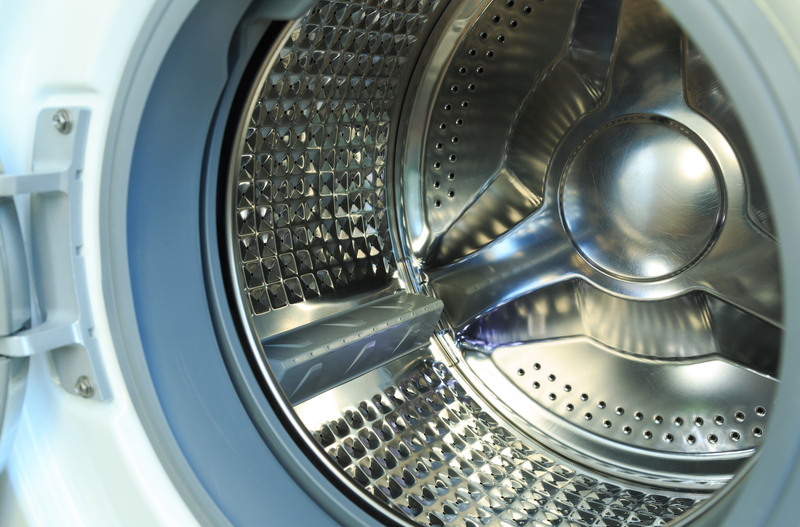Effective Strategies for a Sparkling, Residue-free Stovetop
Posted on 19/06/2025
Effective Strategies for a Sparkling, Residue-free Stovetop
Maintaining a residue-free stovetop can often feel like a losing battle, especially if you love to cook. Between bubbling sauces, spattering oils, and burnt-on messes, your stovetop is prime real estate for stubborn stains and pesky residues. Thankfully, with the right strategies, keeping your stovetop sparkling clean is entirely possible. In this comprehensive guide, we'll delve into powerful, effective stovetop cleaning techniques and maintenance tips to help your kitchen shine every day.

Why Keeping Your Stovetop Clean Matters
Before diving into the step-by-step processes, let's address why it's vital to keep your stovetop spotless. Not only does a clean stovetop make your kitchen look inviting and well-maintained, but it also prevents lingering odors, reduces fire hazards caused by grease buildup, and ensures the longevity of your appliance. Moreover, food residues can affect the flavors of the dishes you cook and may harbor unwanted bacteria. In short, regular attention to your stovetop pays off in appearance, safety, and delicious meals.
Understanding Your Stovetop Type and Its Cleaning Needs
Different stovetops require distinct cleaning methods. Before choosing your cleaning technique, it's essential to identify the material you're working with. Here are the most common types:
- Gas stovetops: Feature removable burners and grates which can be detached for deeper cleans.
- Electric coil stovetops: Feature raised coils, which can be gently lifted to clean underneath them.
- Glass or ceramic cooktops: Offer a flat, sleek surface making them visually attractive and easier to wipe, yet prone to scratching if improper tools are used.
Tip: Always refer to your manufacturer's manual for cleaning recommendations specific to your appliance to avoid unintentional damage.
Daily Cleaning Habits for a Residue-free Stovetop
Consistency is key! Building daily habits helps prevent residues from becoming stubborn stains. Here's a simple daily routine for a sparkling stovetop:
-
Let the Stovetop Cool:
Never attempt to clean a hot surface. Wait for it to cool entirely before starting. -
Wipe Down Spills and Splatters Immediately:
Use a soft cloth or sponge dampened with warm, soapy water to tackle visible messes. Quick action means less scrubbing later. -
Use a Dedicated Cleaner:
For everyday cleaning, opt for a gentle, non-abrasive cleaner formulated for your stovetop's material. -
Buff Dry:
After cleaning, use a microfiber cloth to buff the surface, preventing water spots and streaks.
Deep Cleaning Strategies for a Sparkling Stovetop
Even with daily wipes, your stovetop will periodically need a thorough cleaning to tackle greasy, burnt-on residues. Here are detailed steps to deep clean your stovetop:
Gas Stovetops
-
Remove Grates and Burner Caps:
Carefully take off the grates and burner caps. Soak them in warm, soapy water for at least 20 minutes. For stubborn residue, sprinkle on baking soda and gently scrub with a brush. -
Clean Burner Heads:
Use a toothbrush and a mixture of equal parts vinegar and water to clean burner heads. Unclog any blocked holes with a straight pin. -
Wipe the Surface:
For stuck-on foods, make a paste from baking soda and water. Spread it over stains, let sit for 15 minutes, then wipe with a damp sponge. -
Reassemble Carefully:
Ensure all parts are thoroughly dry before putting everything back.
Electric Coil Stovetops
-
Remove and Soak Drip Pans:
Take off the coils (once cooled) and remove drip pans. Soak pans in hot, soapy water. If they're grimy, sprinkle baking soda and let sit before scrubbing. -
Clean Coils:
Wipe electric coils with a damp cloth. Avoid submerging them in water or using harsh chemicals. -
Address the Surface:
Clean the base with the same gentle solution, ensuring no liquid enters electric connections.
Glass or Ceramic Cooktops
-
Surface Preparation:
Use a damp cloth to remove loose debris first. -
Apply Cooktop Cleaner:
Spread a specialized glass cooktop cleaner or a paste of baking soda and water across stubborn spots. -
Scrape Gently:
Hold a razor blade scraper at a 45-degree angle to gently remove hardened residue without scratching. -
Buff to Shine:
Polish the surface with a microfiber cloth until it's streak-free and gleaming.
Natural Cleaning Solutions for a Residue-free Stovetop
Prefer to avoid chemical cleaners? Eco-friendly and natural methods are not only effective but keep your kitchen healthier. Try these proven remedies:
- Baking Soda: A mildly abrasive, safe-for-most-surfaces powder that lifts stuck-on food and neutralizes odors.
- White Vinegar: Dissolves grease and shines surfaces. Spray it on, let sit, then wipe away for a streak-free finish.
- Lemon Juice: Its acidity breaks down grease and leaves a fresh scent. Rub directly onto stains or combine with baking soda for a scrubbing paste.
- Hydrogen Peroxide: When paired with baking soda, it's great for whitening and brightening your stovetop, especially for glass cooktops.
Tip: Always do a spot test on an inconspicuous area to ensure the natural solution doesn't damage your particular stovetop model.
Preventative Measures for a Spotless, Sparkling Stovetop
Long-lasting cleanliness comes down to prevention. Here's how to reduce the chances of residue buildup and maintain that residue-free, sparkling stovetop:
- Use splatter screens: When frying or boiling vigorously, splatter guards catch grease and liquids before they hit the surface.
- Cover pots and pans: Use lids to minimize splash and spatter during cooking.
- Clean as you go: Wipe up spills immediately after they happen (once cooled).
- Line pans: Use aluminum foil or silicone mats on drip pans and under burners for effortless cleanup.
- Maintain vent hoods: A well-functioning range hood extracts airborne grease, reducing surface deposits.
Addressing Stubborn, Burnt-on Residue
Sometimes, despite your best efforts, spills get overlooked and burn onto your stovetop. Don't worry--these deep cleaning techniques can revive even the most neglected surfaces:
-
Baking Soda and Vinegar Paste:
Sprinkle baking soda over the stain. Spray vinegar on top. Let the mixture fizz for 10-15 minutes, then gently scrub with a non-abrasive sponge. -
Lemon and Salt Scrub:
Cut a lemon in half, dip the cut side in salt, and use it as a natural scrubbing tool over tough spots. Wipe clean with a damp cloth. -
Commercial Cream Cleaner:
For glass cooktops, a non-scratch cream cleaner can tackle persistent marks. Apply as directed, then buff to a shine. -
Soak and Scrape:
For severe cases, lay a hot, damp towel over the stubborn stain for 30 minutes to soften it, then use a plastic scraper to remove the loosened debris.
Maintenance Schedule for a Stovetop That Stays Sparkling
Adopting a periodic cleaning schedule helps catch messes before they become ingrained. Here's an optimal stovetop cleaning timeline:
- After each use: Quick wipe with a damp cloth.
- Weekly: Deeper clean, focusing on grates, burners, and drip pans.
- Monthly: Check for hidden buildup under coils or beneath grates and treat with a strong cleaner or method of choice.
Set reminders if needed--consistency is what keeps a residue-free stovetop glowing day after day.
Essential Tools for an Immaculate, Residue-free Stovetop
Equipping yourself with the right tools makes the process faster and prevents accidental damage. Here are must-haves for any kitchen:
- Microfiber cloths for streak-free drying and polishing.
- Non-abrasive sponges for daily cleaning.
- Old toothbrush to reach tight corners and crevices around burners.
- Plastic or razor blade scrapers for stuck-on residue (use only on appropriate surfaces).
- Dedicated stovetop cleaner or natural cleaning supplies like vinegar, baking soda, and lemon.
Note: Avoid using steel wool or harsh scouring pads on glass surfaces--they can leave permanent scratches and diminish your cooktop's appearance.

Common Mistakes to Avoid for a Residue-free, Sparkling Stovetop
Some well-intentioned actions can backfire when cleaning your stovetop. Steer clear of these pitfalls:
- Using abrasive materials--they scratch and cloud sensitive surfaces.
- Spraying directly on controls or electrical connections--excess moisture can cause malfunction or corrosion.
- Neglecting spots under heating elements--hidden debris can burn and emit odors.
- Skipping regular maintenance--which leads to harder-to-tackle buildups.
- Mixing incompatible cleaners--creates fumes or damages finish (always check labels for warnings).
Final Thoughts: Achieving and Maintaining a Spotless, Residue-free Stovetop
With these effective stovetop cleaning strategies and maintenance routines, you can effortlessly enjoy a sparkling, residue-free stovetop every day. The key is regular care--wiping up messes as they happen, deep cleaning periodically, and using the right tools and techniques for your cooktop type. Prevention goes a long way, but even burnt-on messes can be conquered with a bit of patience and the right approach.
Invest a few minutes daily, and the pride of a spotless stovetop will be yours--alongside delicious meals and a welcoming kitchen. For more expert tips on kitchen cleaning and appliance care, revisit this guide and keep your stovetop gleaming for years to come!





